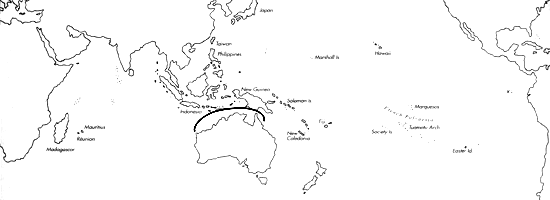Range: W. and N. Australia, from Exmouth Gulf to Arafura Sea; probably also in N. Queensland.
Description: Medium-sized to large, moderately solid to solid: form adami (Pl. 24, Fig. 5) lighter than typical form. Last whorl conical or ventricosely conical to broadly or broadly and ventricosely conical; outline variably convex at adapical third to two-thirds, straight below. Basal part of columella with waist and weak plait posteriorly. Shoulder angulate; in form adami, shoulder carinate and outwardly curved. Spire low, particularly so in form adami; outline slightly concave to slightly convex or apex protruding from an otherwise flat spire. Larval shell of about 1.5 whorls, maximum diameter 1.6- 1.8 mm. Postnuclear spire whorls smooth, with a broadly carinate inner margin in form adami. Teleoconch sutural ramps flat or slightly concave, with 2-3 increasing to 5-12 spiral grooves that are separated by narrow but pronounced ribs. Last whorl usually with a few weak or strong ribs or ribbons at base; additional ribs may be present below shoulder and in some specimens these are followed by ribbons to base.
| Shell Morphometry | ||
|---|---|---|
| L | 40-92 mm | |
| RW | 0.18-0.50 g/mm | |
| (L 40-75 mm) | ||
| RD | 0.65-0.76 | |
| (-form adami 0.65-0.79) | ||
| PMD | 0.80-0.93 | |
| (- form adami 0.90-0.97) | ||
| RSH | 0.03-0.12 | |
| (- form adami 000-0.05) | ||
Ground colour white. Last whorl with 2 continuous or interrupted yellowish to dark brown spiral bands, usually leaving ground-colour zones of varying width below shoulder, at centre and at base. Dotted orcoarse solid brown spiral lines extend from base to shoulder, usually sparse or absent within white zones. Posterior white bands may be interspersed with brown axial markings. White shells intergrade with largely brown shells. In form adami, dark areas variably reduced, central ground-colour band often edged with brown flecks adapically. Larval whorls white or brownish orange. Teleoconch sutural ramps with brown radial markings, ranging from completely white to nearly solid brown. Aperture white.
Periostracum light brown, thin, partially translucent, with spiral rows of tufts on last whorl (Turnbull, pers. comm., 1987). In form adami, periostracum greyish olive, thin and translucent, with spiral ridges on last whorl and a single row of long bristles along outer margin of sutural ramps.
Habitat and Habits: Intertidal to about 150 m; typical form to about 60 m, on muddy sand in intertidal habitats and on sand mixed with coral rubble in subtidal habitats (Turnbull, pers. comm., 1987); form adami in 80-150 m in the Gulf of Carpentaria and in the Arafura Sea. Structure of radular teeth predicts vermivory (Tumbull, pers. comm., 1987).
Discussion: C. trigonus somewhat resembles C. capitaneus and C. namocanus in outline and pattern of the shell. C. capitaneum differs in its yellow apex, narrower (0.9 mm) and multispiral larval shell, dark brown baqe and in the presence of brown flecks at either side of the central ground colour band. C. namocanus can be distinguished by its consistently solid and usually finer spiral lines on the last whorl, purple or bluish violet aperture, weaker spiral sculpture on the late sutural ramps, and by the absence of a contrastingly white base. The olive tones often seen in C. namocanus and C. cupitaneus and the tubercles of their first postnuclear whorl are absent in C. trigonus. C. adami (Pl. 24. Fig. 5) refers to a deep-subtidal form of C. trigonus. All characters mentioned above intergrade between the typical form and form adami; intermediate shells occur at various localities.

C. trigonus range map
This section contains verbatim reproductions of the accounts of 316 species of Conus from the Indo-Pacific region, from Manual of the Living Conidae, by Röckel, Korn and Kohn (1995). They are reproduced with the kind permission of the present publisher, Conchbooks.
All plates and figures referred to in the text are also in Röckel, Korn & Kohn, 1995. Manual of the Living Conidae Vol. 1: Indo-Pacific Region.
The range maps have been modified so that each species account has it own map, rather than one map that showed the ranges of several species in the original work. This was necessary because each species account is on a separate page on the website and not confined to the order of accounts in the book.